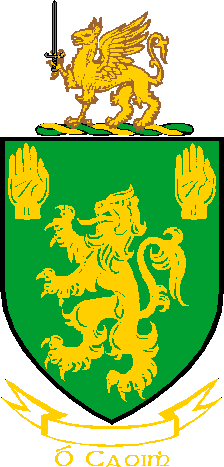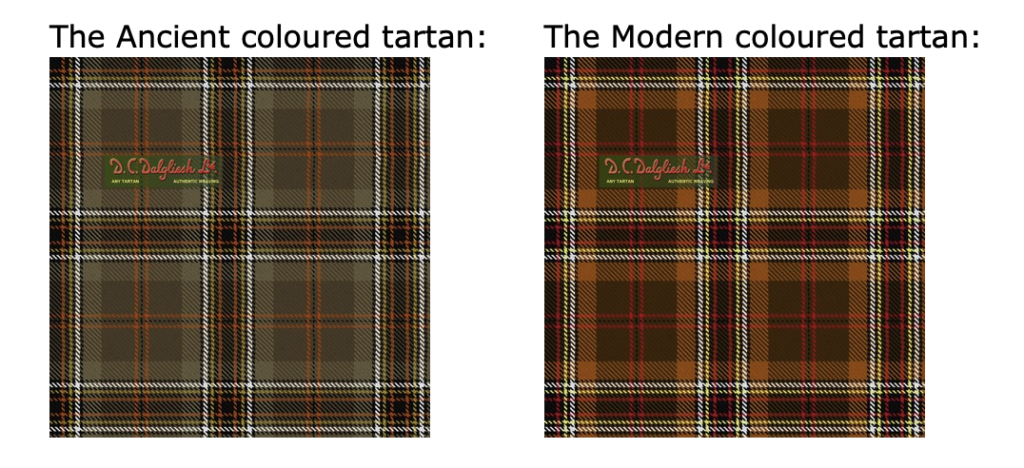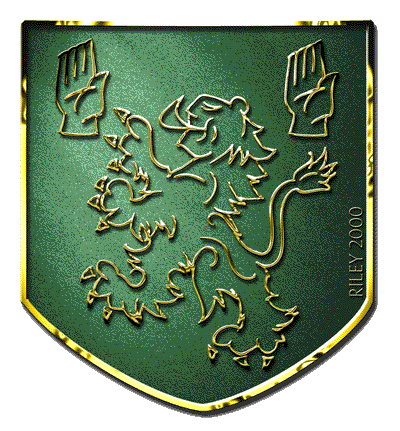Surname | Coat of Arms | Kings | Castles | Gathering | Articles | Notables
Coat of Arms
by Anthony Okieffe

The O’Keeffe Coat of Arms design was found in Burke’s General Armory, one of the greatest collections of Coat of Arms for the families of England, Scotland and Ireland. The book was written by British officer of arms and genealogist Sir John Bernard Burke (5 January 1814 – 12 December 1892). Heraldic artists who created these Coats of Arms for various families across the three countries developed their own language to describe each Coat of Arms. The Arms (or shield) s described by the Heraldic people as follows: “Vert. A lion ramp. Or, in chief two dexter hands couped at the wrist erect and apaumee of the last.”
Above the shield and helmet is the Crest which is described as: “A Griffin pass. or, holding in the dexter claw a sword ppr.”
In normal language, the Coat of Arms depicts a gold lion rampant on a green shield with two gold dexter arms erect. The colours of green and gold have been the original O’keefe Coat of Arms and Crest colours for centuries and they haven’t been changed since then.
References:
Burke, John Bernard. Burke’s General Armory of England, Ireland, Scotland and Wales. London, England: Harrison & Sons Co. Ltd., 1848.
O’Keeffe Motto
by Anthony Okieffe
The O’keefe Motto was created centuries ago, though there is no proper and confirmed date of creation, where it was created or who was credited with its creation, though it is certain that it was an original Irish O’Keefe. The Motto is written in both Latin and Irish Gaelic, now being seen with its English translation.
The Motto in Latin is: “Forti et fideli nihil difficile.”
In Irish Gaelic, the Motto is as follows: “Do na daoine atá cróga agus dílis níl a dhath doiligh.”
In English, the Motto translates as: “For the brave and faithful, nothing is difficult.”
There also has been speculation that there is a Norman-French translation, seeing that most Irish family mottoes were done in either Latin or Norman-French, but there is no recorded evidence of such a version of the O’Keefe Motto.
References:
wikipedia.org
O’Keeffe Tartan
by Anthony Okieffe
The O’Keefe Tartan (also called the Murphy or Tara tartan) was a tartan copied and re-designed off the Maclean of Duart tartan. It was sold to Irish costumers in The Kilt Shop in Edinburgh in 1967. Like many of the Irish tartans on record, it was thought to have been included in the book Clans Originaux, published in Paris in 1880. However, recent research undertaken by the Scottish Tartans Authority has shown this work to be a tartan sample book of sorts, containing no Irish tartans whatsoever.
Most Irish tartans were designed, produced and marketed by Scottish tartan manufacturers. Most were made during the end of the 19th century due to the fact that Irish people wanted to revive the Gaelic traditions, such as education, the Gaelic language and literature. The revival started due to the Irish wanting to separate themselves as a reaction to the British rules at the time.
The O’Keefe Tartan has two variants, the Ancient coloured tartan then the Modern coloured tartan. There is also a Reproduction coloured tartan, but not many companies make this style of tartan.

If you look closely, you’ll notice that they are in the same design and colours, but the Ancient coloured tartan appears look washed out, whereas the Modern coloured tartan appears to be more eye-popping and brightly coloured.
References:
Dunlevy, Mairead. Dress in Ireland. Doughcloyne, Wilton, Cork: Collins Press, 1999.
McClintock, Henry F. Handbook on the Traditional Old Irish Dress. Dundalk, Ireland: Dundalgan Press (W. Tempest) Ltd., 1958.
The O’Keeffe Coat of Arms & The O’Keeffe Crest
by Patricia O’Keeffe, Newmarket.

The Meaning of Symbols and the Colours on the O’ Keeffe Coat of Arms and
The O’ Keeffe Family Crest:
The O’Keeffe Coat of Arms design can be found in Burke’s General Armory, one of the greatest collections of Coat of Arms for the families of England, Scotland and Ireland.
Heraldic artists developed their own unique language to describe each individual Coat of Arms. This book was written by Sir Bernard Burke, England, 1824-1892.
The O’ Keeffe Coat of arms and Crest and motto were legally applied for in France. In 1740 Constantine O’ Keeffe applied to have his lineage and arms registered in France, Constantine, who had been an ensign in Boisseleau’s in 1689 submitted evidence that he was an elder brother of Arthur O’ Keeffe late Counsellor of the king in the Admiralty of France. It was certified that his father, Arthur O’Keeffe, had had portion of his patrimony restored to him during the reign of James II and had rendered excellent service in the wars in Ireland as captain of a company which he had levied himself. (At least two Arthur O’ Keeffes were outlawed for supporting James II.) Five of his children had come to France where three of them died in service. Constantine was wounded and his brother killed at the battle of Ramillies (1706) (O’Murchadha, Diarmuid. Family Names of County Cork. Glendale Press). See Article on “O’ Keeffe of Ireland and Isle of France (Mauritius), Cork Historical and Archaeological Society, Vol. 11, 1893 for confirmation of above.
Above the shield and helmet is The O’ Keeffe Family Crest which is described as:
“A griffin pass. Or, holding in the Dexter (right handed skilled) claw a sword ppr.”
In the O’ Keeffe Crest the term ‘Griffen’ generally means that the lion was traditionally considered the king of the beasts and the eagle the king of birds, the griffin was thought to be an especially powerful and majestic creature. The griffin was also thought of as king of all creatures. Griffins are known for guarding treasure and priceless possessions
The open hand it is thought was used to communicate the ancient Celtic language, Ogham, and was thought to be a symbol for the sun, and the two hands are yellow, the heraldic colour of generosity.
The O’Keeffe Motto
In Latin: – “FORTI ET FORDELI NIHIL DIFFICILE”
In English: – “Nothing is difficult for the Brave and Faithful”
In Irish: – “Do na daoine ata croga agus dilis nil a dhath doilligh”
Meaning of O’Keeffe Name
The Irish surname O’Keeffe is an anglicized form of the Gaelic O’Caoimh. The prefix ‘O’ signifies ‘grandson of’ or ‘descendant’ of. From the Gaelic the name translates as the “male descendant of Caomh”, a byname meaning noble or gentle. O’Keeffe ranks amongst the top hundred surnames in Ireland, and unlike many O’ names, is one which has retained the prefix consistently through the centuries. Different spellings of the same original surname are a common occurrence
The O’Keeffe’s and Keeffe’s are the descendants of the Irish sept of O’Caoimh, who were originally, located in north east County Cork. The surname O’Keeffe originates from Caoimh, meaning ‘Gentle’. The arrival of the Normans meant a displacement of the O Keeffe’s from the Glanworth area. And they moved to Duhallow, where they prospered up till the eighteenth century. The stronghold of the name in the Duhallow region became known as Pobal O’Keeffe. The name was displaced in the eighteenth century and established in France. The name today, is ranked as the ninety second most numerous name in Ireland, with County Cork being the most favoured location, and then Munster in general. Surnames originated for the purpose of more specific individual family identification.
1659 O’ Keeffe Census
It is worth noting according to the Census of 1659 there were twelve O’ Keeffe families in Cork city and forty six in Barrymore, ( Which includes Glenville and Dunbulloge) while the rest of the country had too few to record. (It must be borne in mind that the returns for Duhallow are missing.) Also, there were thirty two O’ Keeffe families in the adjoining Co. Limerick, and, more surprisingly, thirty on Co. Kilkenny.
O’Murchadha, Diarmuid. Family Names of County Cork. Glendale Press
Patricia O’ Keeffe, Newmarket

